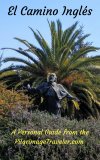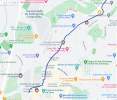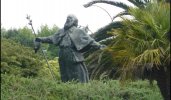I have read that the statues of the two pilgrims on Monte do Gozo were erected in 1993, a Holy Year. The sculptor was José María Acuña López. But Acuña died in 1991, at least 12 months or up to 3 years earlier. I don't suppose that Acuña was working up to the day of his death. Do you know why there was this gap between Acuña's death and the intallation of the statues? Do you know when the work was commisioned? Were they in storage for a year or two?
-
 ⚠️ Emergency contact in Spain - Dial 112 and AlertCops app. More on this here.
⚠️ Emergency contact in Spain - Dial 112 and AlertCops app. More on this here. -
Remove ads on the forum by becoming a donating member. More here. -
Get your Camino Frances Guidebook here.
Search 74,075 Camino Questions
You are using an out of date browser. It may not display this or other websites correctly.
You should upgrade or use an alternative browser.
You should upgrade or use an alternative browser.
The one from Galicia (the round) and the one from Castilla & Leon. Individually numbered and made by the same people that make the ones you see on your walk.
- Time of past OR future Camino
- 2007
Really good questions. If I am understanding correctly, he started this particular work in 1987. So perhaps it was already completed before the 1993 Holy Year, which would have been a special time to unveil it in his late honor. This was the best I could find - but like you, I'd love to know more details.
Acuña, como Beethoven y Goya (archive, no paywall)
Acuña, like Beethoven and Goya (Google translate to English)
- Time of past OR future Camino
- To Santiago and back. Le Puy to Aumont-Aubrac.
The linked article refers to a different pilgrim statue by Acuña. It can be found in Santiago itself and is apparently rarely photographed or seen by forum members.If I am understanding correctly, he started this particular work in 1987.
See here:
And also here:

... Cuando Rouco Varela acudió a la inauguración del Monumento al Peregrino de Praza da Paz
José María Acuña es recordado en Santiago por su trabajo entorno a la peregrinación, que inspiró al escultor sordomudo en tres de sus obras. En la pri...
 www.elcorreogallego.es
www.elcorreogallego.es
...and ship it to Santiago for storage. You pick it up once in Santiago. Service offered by Casa Ivar (we use DHL for transportation).
- Time of past OR future Camino
- To Santiago and back. Le Puy to Aumont-Aubrac.
See footnote 26 in Peregrinos en piedra y bronce. El monumento conmemorativo jacobeo como patrimonio cultural y artístico del Camino by José Javier Azanza López. Who would have guessed that?I'd love to know more details
Marc S.
Active Member
- Time of past OR future Camino
- Some in Spain, Portugal, Germany and Netherlands
According to this article the sculptures were made before 1991, and replaced to Monte de Gozo in 1993. (if I understand correctly, my knowledge of Spanish is limited). It does not mention where the sculptures were originally placed.
Actually his sculpture near O Cobreiro was also placed there in 1993 (at least that is what I read regularly) - after his death.
 www.guanella-camino.org
www.guanella-camino.org
Actually his sculpture near O Cobreiro was also placed there in 1993 (at least that is what I read regularly) - after his death.
Los Peregrinos: Monte do Gozo – Guanelianas en el Camino
 www.guanella-camino.org
www.guanella-camino.org
Last edited:
And we have yet another internet discrepancy! All the sites I looked at (OK 'all' = 2 or 3) said that the statues were erected in 1993 (a Holy Year, deffo), but that footnote in that very authoritative article says it was erected in 1994. Perhaps it was erected in 1993 but unveiled by some important celebrity in 1994? The footnote also says that the work is 3 metres high. Would that be the height of the figures or the height to the top of the higher staff?See footnote 26 in Peregrinos en piedra y bronce. El monumento conmemorativo jacobeo como patrimonio cultural y artístico del Camino by José Javier Azanza López. Who would have guessed that?
And thanks, Kathar1na, for another great piece of detective work!
Holoholo automatically captures your footpaths, places, photos, and journals.
The first edition came out in 2003 and has become the go-to-guide for many pilgrims over the years. It is shipping with a Pilgrim Passport (Credential) from the cathedral in Santiago de Compostela.
- Time of past OR future Camino
- Us:Camino Frances, 2015 Me:Catalan/Aragonese, 2019
- Time of past OR future Camino
- 2007
See footnote 26 in Peregrinos en piedra y bronce. El monumento conmemorativo jacobeo como patrimonio cultural y artístico del Camino by José Javier Azanza López. Who would have guessed that?
Great find and a very interesting article. Thank you. It's incredible that Acuña first sketched the idea for this work (the one now in Monte do Gozo) in 1940. That charcoal drawing must also be a beauty to behold.
From footnote 26.... "Digno de mención es el proceso creador de la obra por parte de Acuña, cuyo origen se encuentra en un dibujo a carbón sobre papel que realizó hacia 1940 (La llegada a Santiago. 1940 ca. Carbón sobre papel. 22,3 x 16 cm)" / "Worthy of mention is the creative process of the work by Acuña, whose origin is found in a charcoal drawing on paper that he made around 1940 (Arrival in Santiago. c 1940. Charcoal on paper. 22.3 x 16cm)"
Last edited:
- Time of past OR future Camino
- Too many to count!
This statue is right along the English Way, and yes, it is difficult to spot, because as you walk southward you must turn around and look backwards to see it, in the roundabout where it resides. It is in the Praza da Paz, in the center of this large roundabout, just after you walk by the large administrative buildings of the Xunta da Galicia, about 1.5 km from the cathedral. It's a shame that more pilgrims don't see it. I liked it so much as used it on the cover of my resource.Taken on a trial run to the old bus station with Peg so she could meet up with me in Fisterra.
View attachment 138452

Edit: Here's a map of its location, it's the yellow star:

Last edited:
3rd Edition. More content, training & pack guides avoid common mistakes, bed bugs etc
- Time of past OR future Camino
- Us:Camino Frances, 2015 Me:Catalan/Aragonese, 2019
This statue is right along the English Way, and yes, it is difficult to spot, because as you walk southward you must turn around and look backwards to see it, in the roundabout where it resides. It is in the Praza da Paz, in the center of this large roundabout, just after you walk by the large administrative buildings of the Xunta da Galicia, about 1.5 km from the cathedral. It's a shame that more pilgrims don't see it. I liked it so much as used it on the cover of my resource.
I dropped a pin on the statue; it can be seen with Google Maps' satellite view. Going around the traffic circle using Street View it can also be seen but not very well. It is surrounded by shrubbery.
42°53'19.3"N 8°32'09.7"W · Praza da Paz, 15704 Santiago de Compostela, A Coruña, Spain
Praza da Paz, 15704 Santiago de Compostela, A Coruña, Spain
Marc S.
Active Member
- Time of past OR future Camino
- Some in Spain, Portugal, Germany and Netherlands
From footnote 26.... "Digno de mención es el proceso creador de la obra por parte de Acuña, cuyo origen se encuentra en un dibujo a carbón sobre papel que realizó hacia 1940 (La llegada a Santiago. 1940 ca. Carbón sobre papel. 22,3 x 16 cm)" / "Worthy of mention is the creative process of the work by Acuña, whose origin is found in a charcoal drawing on paper that he made around 1940 (Arrival in Santiago. c 1940. Charcoal on paper. 22.3 x 16cm)"
Thank you for quoting the full text of the footnote. I struggle to find the article (and can't really read Spanish either), but does the article mention when he actually made the pilgrim sculptures and where they were untill 1993/4 ?
- Time of past OR future Camino
- please see signature
it is difficult to spot, because as you walk southward you must turn around and look backwards to see it, in the roundabout where it resides
It is surrounded by shrubbery
I'm a self confessed "expert" in using street level imagery.
It still took me a quite a few moments to find its exact location in the shrubbery: image dated Sep 2022.
Might this be a case for the "relevant authorities" to have it "translated" to a place where a majority of pilgrims would see it, with a suitable plaque noting the subject and artist.
The 2024 Camino guides will be coming out little by little. Here is a collection of the ones that are out so far.
- Time of past OR future Camino
- 2007
Thank you for quoting the full text of the footnote. I struggle to find the article (and can't really read Spanish either), but does the article mention when he actually made the pilgrim sculptures and where they were untill 1993/4 ?
Sorry, no, unfortunately. Just that the Monte de Gozo work was erected in 1994, as @Bert45 noted. Nothing about the time between Acuña's passing and its placement.
If you scroll to the photos at the end of the article, his statue on Alto San Roque is stated to have been erected in 1993. There is no photo of his beautiful statue in Santiago (thanks everyone for the info and special photos), but thanks to @Kathar1na we know that he celebrated its placement himself in 1987.
Here is the link to the article @Kathar1na found, with the relevant portions translated to English (via Google translate):
🥇 ProtectedPool ➤ Most Powerful and Safest Web3 Smart DeFi Wallet 🔐
🥇 ProtectedPool ➤ Web3 Smart DeFi Wallet 🔐 . Your New DeFi Experience:: 🔐 Secure, Smart, Simple. Double Approvals. Add extra confirmation of any transaction with 2FA solutions including Google Authenticator or hardware security keys. Self-custodial Solutions. Protected Pool is built on smart...
"Joy that overflows when from Monte do Gozo, they spot the background the towers of the cathedral of Santiago. “The arrival” by José María Acuña, a work of three meters high, installed in 1994 on Monte do Gozo, reproduces the joy of the pilgrims when they see the end of the path (Fig. 8). The sculptures stand out for the expressive force of gestures, again in a way characterizing the virtuosity of detail and the sincere expression of feelings in the work of the Galician sculptor. 26
"26 Worthy of mention is the creative process of the work by Acuña, whose origin is found in a charcoal drawing on paper that he made around 1940 (The arrival in Santiago. 1940 ca. Charcoal on paper. 22.3 x 16 cm); five decades later the set was transferred to a small bronze (The Arrival. 1990. Bronze. 48.5 x 31 x 30 cm). Finally, in 1994 –the artist having passed away- the 3m monumental complex was executed from the original bronze.
"Fig. 8. José María Acuña. La llegada. Monte do Gozo. 1994. Foto: J. J. Azanza."
Last edited:
We're talking about two (or three) different statures here, Alwyn, There is the one in Praza da Paz and the other work, consisting of two figures, on Monte do Gozo. I am asking about the work on Monte do Gozo, which turns out to be an enlarged version produced after Acuña's death of a small maquette produced by him in his lifetime (obvs).I'm a self confessed "expert" in using street level imagery.
It still took me a quite a few moments to find its exact location in the shrubbery: image dated Sep 2022.
Might this be a case for the "relevant authorities" to have it "translated" to a place where a majority of pilgrims would see it, with a suitable plaque noting the subject and artist.
- Time of past OR future Camino
- please see signature
@Bert45, thank you for the clarification. And yes, the title of your thread is quite clear.I am asking about the work on Monte do Gozo
With the assistance of @Kathar1na a lot of light has been shed on Acuña and his works..
I apologize if you feel I have appeared to sidetrack your enquiry.
My thoughts on relocation of the work at Praza da Paz arose like this.
Having read the material your question created, nostalgia had me using street level images to follow the street works leading down from Monte do Gozo and so on to the Cathedral. Even though I often had pilgrims with their poles and packs in the street level images to guide me, I still managed to get lost at times. Very seldom could I see a shell or yellow arrow to show the way ahead. And I reflected how I was guided out of Leon with yellow arrows on building corners or street kerbs (sometimes also an "X" showing the way not to go). And, yet again, I got lost exiting from Praza de Cervantes.
And then the Praza de Paz work popped up. And I was off.
Kia kaha (take care, be strong)
3rd Edition. More content, training & pack guides avoid common mistakes, bed bugs etc
❓How to ask a question
How to post a new question on the Camino Forum.
Most read last week in this forum
Ok so ... this past spring (2024) I decided to walk the "lower" route into Pamplona and became really lost. I just keep thinking about it and it really bugs me. Where did I go astray?
At the...
Hi all,
doing the Camino Francés was one of my childhood dreams. I grew up hearing epic stories about it, and wanted to be a part of it.
Like everyone, however, I have my quirks, and wanted to...
I asked the tourist office for information about the statue of the pilgrim at the entrance to Carrión de los Condes. Here is their reply. auto-translated: "The Monument to the Pilgrims" is a...
I understand that footwear on the Camino is a personal choice. I will start my first Camino on the Camino Frances in the first part of April. With the varying weather conditions, what...
Hi everyone. I am in Roncevalles alburgue right now in November 2024. I was quoted 100 euro for luggage transport from Buricot. They said it's slow season and they don't have any other luggage...
I’ve emailed both albergues a while back inquiring about booking for mid-April 2025. They both indicated that they’d take reservations in Nov/Dec. Outside of checking every day, do folks have a...
Similar threads
LIVE from the Camino
Héctor Walked His Way-Successfully!
- Replies
- 105
- Views
- 6K
- Replies
- 8
- Views
- 2K
- Replies
- 16
- Views
- 3K
- Replies
- 17
- Views
- 890
- Replies
- 12
- Views
- 1K
❓How to ask a question
How to post a new question on the Camino Forum.
Most downloaded Resources
-
“All” Albergues on the Camino Frances in one pdf“All” Albergues on the Camino Frances in one pdf
- ivar
- Updated:
-
A selection of favorite albergues on the Camino FrancésFavorite Albergues along the Camino Frances
- Ton van Tilburg
- Updated:
-
Profile maps of all 34 stages of the Camino FrancesProfile maps of all 34 stages of the Camino Frances
- ivar
- Updated:
















